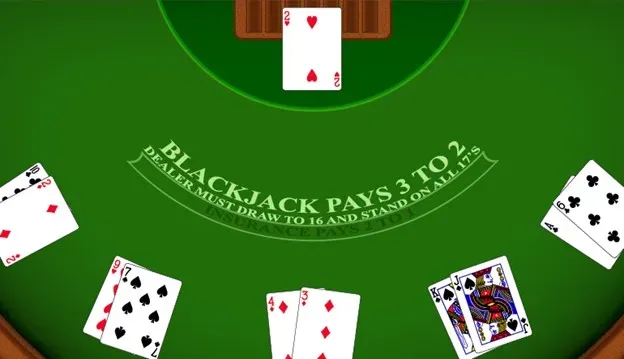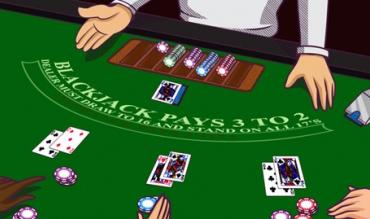Knowing when to double down is a key part of any blackjack player's game. Permitting doubles is one way the house reduces the edge it gets from players having to risk busting first.
Most players who put a little time into learning basic blackjack strategy pick up on when to double hard hands fairly quickly.
Soft hands, where Aces can be counted as 1 or 11, are another matter. Many good players are just a little fuzzy on when to double and when to settle for the basic hit/stand decision.
Doubling Situations
When you double down, it means that after you've seen your first two cards, you may double your bet. You then receive one card – no more, no less – to complete the hand.
Mind you, not every table allows soft doubling. Some restrict double downs to hard totals of 10 or 11, and some restrict them to hard 9, 10 or 11. As a player, you want more options regardless of whether you're playing at live tables or in an online casino, so double down rules are among the things you should check when choosing where to play.
When basic strategy blackjack charts list doubling down as your best play, it's because you have an edge. You won't win every hand, of course. Sometimes doubling your bet means losing double your money. But the average outcome of double-down hands is profit to the player.
Doubling Down in Basic Strategy
How much extra do you make by using basic strategy for doubling down on soft totals? Let's break it down for six-deck games, which are the most common in modern casinos.
Never double in six-deckers with soft totals of 19 or higher. Those win more often than they lose when you stand, and you risk weakening the hand if you double and take one more card.
Nor will you double on soft 12. That's a pair of Aces, and the better play is to split the pair.

That leaves opportunities when you have soft 13 through soft 18 – or Ace-2 through Ace-7.
Average profits listed are per dollar of your original bet. When calculations for Ace-2 vs. a dealer's 6 tells you hitting brings an average profit of 16.6 cents per dollar and doubling raises that to 20.4, it tells you your average profit for a $1 bet is 16.6 cents and that when you double, your profit for what's now a $2 bet is 20.4 cents.
On soft 13-17, strategy is the same regardless of whether the dealer hits or stands on soft 17. Average profits are given for the more common configuration, dealer hits soft 17. On soft 18, there is a difference on whether to double vs. 2, so average results are given for both hit and stand on soft 17 games.
Ace-2 or Ace-3: Double when the dealer shows 5 or 6. Otherwise, hit.
In a common six-deck game where the dealer hits soft 17, you'll average a 16.6 cent profit per dollar wagered if you hit Ace-2 vs. 6. Double down and that average profit per dollar of your original bet rises to 20.4 cents.
That's the way these work. The recommended play is to double only if the average profit per dollar of your original bet rises.
With Ace-2 vs. 5, average profits per dollar are 13.8 cents if you hit, 14.1 if you double.
When you start with Ace-3, average profits are 14.6 cents on hit, 20.3 on double vs. 6, and 11.6 on hit, 14.0 on double vs. 5.
Ace-4 or Ace-5: Double when the dealer shows 4. 5 or 6. Otherwise, hit.
Let's take Ace-4 first, and list average profits per dollar of original wager for hitting, followed by for doubling. Against a dealer's 4, averages are 6.1 and 6.5 cents; against a 5, they're 9.5 and 13.5, and against a 6, they're 12.6 and 20.
Same drill for Ace-5. Against a 4, averages are 4.1 and 6.2, against a 5, they're 7.5 and 13, and against a 6 they're 11.1 and 20.2.
In every case profits per dollar rise when you double down, and basic strategy reflects that.
Ace-6: Double vs. 3, 4, 5 or 6. Otherwise, hit.
Inexperienced players sometimes hit a wall at soft 17. With hard hands, basic strategy calls for us to stand no matter what the dealer has face up.
Soft hands are different because you can't bust them with a one-card hit. And 17 is a hand that can't win unless the dealer busts. The best it can do is push a dealer 17.
Players who know their basic strategy never stand on soft 17. They either hit or take advantage of double-down opportunities when the dealer shows 3, 4, 5 or 6.
Let's run the numbers, listing profit per dollar when standing, then when doubling.
For Ace-6 vs. 3, average profits are 2.9 cents per dollar when hitting or 5.6 when doubling. Averages are 6.2 and 12.3 vs. 4, 9.9 and 19.7 vs. 5, and 12.6 and 25.2 vs. 6.
Ace-7: Double vs. 2 through 6 if the dealer hits soft 17, or 3 through 6 of the dealer stands on all 17s. Otherwise, stand.
Doubling on soft 18 differs in that you stand on the non-doubling hands, whereas you hit soft 17 or lower.
It's also different in that there's a strategy split depending on dealer rules. You double when the dealer shows a 2 if the dealer hits soft 17, but not if he stands.
Let's do numbers assuming hitting soft 17, then detail the stand on soft 17 exception.
Average profits per dollar, with standing listed before doubles, are 6 cents and 11.6 vs. 2, 8.8 and 17.5 vs. 3, 12.2 and 24.5 vs. 4, 15.1 and 30.2 vs. 5 and 17.8 and 35.6 vs. 6.
Now the exception: When the dealer stands on soft 17, it creates extra hands your soft 18 will beat. The dealer doesn't get a chance to improve the 17. That alters the best basic strategy play for Ace-7 vs. 2 to standing. Stand, and the average profit per dollar is 12.3 cents vs. 6.3 when hitting and 12.1 when doubling. The average profit is slightly higher when standing than doubling, and you don't have to risk a second bet to get there.
Single-Deck Strategy Differences
Single-deck games are not common, and when they are available, they usually are loaded with house-favoring rules.
Nonetheless, should you be at a single-deck table, the strategy for soft doubling is a little different.
With Ace-2, Ace-3, Ace-4 or Ace-5: Double against 4, 5 or 6. Otherwise, hit.
With Ace-6: Double against 2 through 6. Otherwise, hit.
With Ace-7: Double against 3 through 6. Otherwise, stand. We don't double against 2 no matter whether the dealer hits or stands on soft 17.
With Ace-8: Double against 6. Otherwise, stand. With six decks, we never double on soft 19. But in a single-deck game where the dealer hits soft 17, average profits per dollar are 44.7 cents if you stand, 23.3 cents if you hit, and 46.7 cents if you double.
If the dealer stands on soft 17, averages are 48.24 cents if you stand, 24.1 if you hit and 48.26 cents if you double. That's such a narrow margin you might choose not to make the second bet, but your long-term average return is highest if you double.
Three or More Card Hands
Standard blackjack games allow double downs only on your first two cards. What about soft hands with more cards, such as Ace-2-3 for soft 16 or Ace-3-4 for soft 18?
In such cases, hit if your soft total is 17 or less. Stand with 19 or higher On soft 18, stand against 8 or lower, but hit against 9, 10 or Ace.
As always with basic strategy, these plays won't work every time but they'll give you the best average result.


